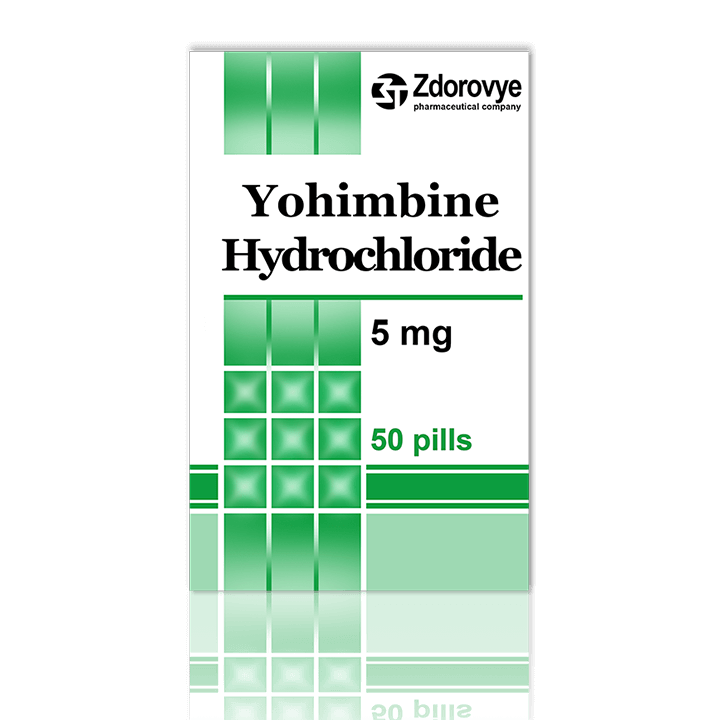Yohimbine Hydrochloride Instruction
International Non-Proprietary Name (INN): yohimbine hydrochloride
Dosage form: pills
Structure
In 1 pill:
Active ingredient: yohimbine hydrochloride 5 mg;
Excipients: potato starch, milk sugar, calcium stearate.
Description
Pills of white or white with a yellowish tint color, with a bevel.
Pharmacological classification: F52.2 Failure of genital response
ATC code: G04BE04
Pharmacological action: agents used for erectile dysfunction

Pharmacodynamics
The yohimbine substance is an effective tool for enhancing potency. It is an alkaloid preparation obtained from the bark of the West African tree Corynanthe Yohimbe. The principle of action of yohimbine hydrochloride is explained by the process of selective blocking of α2-adrenergic receptors. The drug increases the central adrenaline metabolism, activating adrenergic nerve cells in the central nervous system, which provokes the development of a psychostimulating effect and exacerbation of the reaction. The drug is believed to have an effect on the serotonergic, dopaminergic, and cholinergic systems of the nervous innervation.
It has been experimentally established that yohimbine normalizes sexual function and the ability to coitus, weakened after stress; it eliminates the erection inhibition caused by the stimulation of α2-adrenergic receptors. Besides the effect on the central nervous system, the action of the drug is also attributed to the expansion of the penis vessels and the improvement of the blood circulation in the tissues.
The drug is low toxic and does not affect the genetic apparatus of sperm. The effect of yohimbine is manifested only after a certain time. Therefore, a regular intake of the drug is recommended. Periodic inhibitions of the effectiveness of yohimbine hydrochloride during the second and third week of the treatment may be associated with the accumulation of the active product 11-hydroxyohymbin.
Pharmacokinetics
Absorption. Yohimbine is completely absorbed in the digestive tract 45–60 minutes after ingestion. The maximum concentration in the blood is reached approximately 45–75 minutes after an oral administration. AUC (area under the plasma concentration curve) as a measure of bioavailability shows pronounced fluctuations. This is due to the effect of the first passage through the liver. Cmax and AUC are dose-dependent. Cumulation of the drug, when administered in recommended doses, does not occur.
Distribution. The substance is evenly distributed in the tissues. 82% of yohimbine in plasma binds to protein. Only a small amount of the drug is found in the intercellular fluid.
Metabolism. The drug is metabolized both inside and outside the liver. Two types of metabolites are detected – 11-hydroxy-yohimbine is more active, and 10-hydroxy-yohimbine is less active.
Excretion. The elimination half-life after a single dose varies from 0.25 to 2.5 hours. In a prolonged treatment, yohimbine hydrochloride is excreted within a period from 60 minutes to 8 hours.
Intended uses
Various types of erectile dysfunction.
Contraindications
- hypersensitivity to the drug;
- hepatic and/or renal failure;
- arterial hypertension or hypotension;
- simultaneous administration of adrenal stimulants;
- safety and effectiveness have not been established in pediatric patients (under 18 years old).
With caution: Heart disease (ischemic disease, arrhythmia), peptic ulcer of the stomach and duodenum, mental illness, glaucoma.
Dosage and administration
The drug is taken orally during meals, without chewing, with a glass of water. Recommended dose: 1-2 tablets 1-3 times a day.
Usually, the dosage is prescribed for every patient individually. The initial dose can be half a tablet three times a day, with a gradual increase to 1-2 tablets (5–10 mg) three times a day.
In some cases, the effect of the treatment can be delayed and develop only after 14–20 days from the beginning of the course.
The duration of treatment is 3-4 weeks. After a break, the course can be repeated, but not earlier than after 10 weeks.
Precaution
A small amount of lactose is present in the composition of yohimbine hydrochloride, this should be taken into account when prescribing the drug to people with galactose intolerance, lactase deficiency, and with the pathology of glucose-galactose malabsorption.
Side effects
Sometimes, taking yohimbine hydrochloride may be accompanied by undesirable reactions:
- heart palpitations;
- pain in the head, sleep disturbances, irritability, trembling hands, increased sweating, a feeling of anxiety;
- rarely – nausea and vomiting, loss of appetite, diarrhea;
- hyperemia of the skin;
- increased blood pressure;
- a decrease in the daily amount of urine, prolonged erection without sexual arousal;
- allergic response.
Overdose
Symptoms
General weakness, generalized paresthesia, impaired memory and movement coordination, headache, dizziness, tremor, tachycardia, arterial hypertension, a sense of fear, hallucinations, nausea, vomiting, mydriasis, salivation and lacrimation, increased sweating, increased levels of norepinephrine in the blood plasma. Pain behind the sternum may occur and continue for several hours 4 hours after taking a large amount of yohimbine hydrochloride.
Treatment
Cancel the drug, lavage the stomach, and take sorbent drugs (activated charcoal). Clonidine can act as an antidote for the neutralization of mental manifestations in an overdose. It is prescribed in the amount of 0.1–0.2 mg orally. Further repeated intakes of Clonidine are possible in the amount of 0.1 mg every 60 minutes until the heart stabilizes and the patient’s condition is alleviated. Symptomatic treatment: antihypertensive drugs; benzodiazepines to eliminate a sense of fear or hallucinations (neuroleptics of the phenothiazine series cannot be prescribed).
Interaction with other drugs
The simultaneous administration of Clonidine is not recommended, as the effects of the drugs are mutually neutralized. Yohimbine can change the activity of antihypertensive drugs, potentiate the effect of antidepressants and increase the risk of their side effects, reduce the activity of Alprazolam. Clopiramine increases the level of yohimbine in blood plasma.
Pregnancy and lactation
The drug yohimbine hydrochloride is prescribed only to men.
Influence on the ability to drive vehicles and operate mechanisms
Given that patients with increased individual sensitivity to the drug may experience adverse reactions (dizziness, tremor) when taking it, they should refrain from driving vehicles and operating mechanisms that require concentration during the treatment.
Storage conditions
Store in a dry place, at a temperature not exceeding 25°C (77°F). Keep out of the reach of children.
Shelf life
3 years.
Manufacturer
Pharmaceutical company “Zdorovye”, Ukraine. https://zt.com.ua/en/